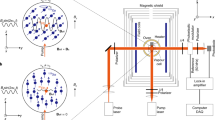Abstract
The axion is one of the main candidates of dark matter and was originally introduced to solve the strong CP problem of quantum chromodynamics. Here we present a proposal to search for QCD axions with mass in the 200 μeV range, assuming that they make a dominant component of dark matter. Since the axion can couple to the spin of a fermion, its presence can be seen as the existence of an equivalent rf field with frequency and amplitude fixed by the axion mass and coupling, respectively. This equivalent magnetic field would produce spin flips in a magnetic sample placed inside a static magnetic field, which determines the resonant interaction at the Larmor frequency. Spin flips would subsequently emit radio frequency photons that can be detected by a suitable quantum counter in an ultra-cryogenic environment. An updated report of the experimental results will be presented, together with a preliminary measurement and a projection of future improvements.
Access this chapter
Tax calculation will be finalised at checkout
Purchases are for personal use only
Similar content being viewed by others
References
Planck Collaboration: P.A.R. Ade et al., Astron. Astrophys. 594, A13 (2016)
R.D. Peccei, H.R. Quinn, Phys. Rev. Lett. 38, 1440 (1977); Hwang, P. Sikivie, D. Tanner, R. Bradley, J. Clarke, Phys. Rev. Lett. 104, 041301 (2010)
R. Barbieri et al., Phys. Dark Univ. 15, 135141 (2017)
G. Ruoso et al., J. Phys. Conf. Ser. 718, 042051 (2016)
L.M. Krauss, J. Moody, F. Wilczeck, D.E. Morris, Spin coupled axion detections. Preprint HUTP-85/A006 (1985)
R. Barbieri, M. Cerdonio, G. Fiorentini, S. Vitale, Phys. Lett. B 226, 357 (1989)
F. Caspers, Y. Semertzidis, Ferri-magnetic resonance, magnetostatic waves and open resonators for axion detection, in Proceedings of the Workshop on Cosmic Axions, ed. by C. Jones, A. Melissinos (World Scientific Publishing Co., Singapore, 1990), p. 173
A.I. Kakhizde, I.V. Kolokolov, Sov. Phys. JETP 72, 598 (1991)
P.V. Vorob’ev, A.I. Kakhizde, I.V. Kolokolov, Phys. At. Nucl. 58, 959 (1995)
Author information
Authors and Affiliations
Corresponding author
Editor information
Editors and Affiliations
Rights and permissions
Copyright information
© 2018 Springer International Publishing AG, part of Springer Nature
About this paper
Cite this paper
Crescini, N. et al. (2018). Searching Axions through Coupling with Spin: The QUAX Experiment. In: Carosi, G., Rybka, G., van Bibber, K. (eds) Microwave Cavities and Detectors for Axion Research. Springer Proceedings in Physics, vol 211. Springer, Cham. https://doi.org/10.1007/978-3-319-92726-8_17
Download citation
DOI: https://doi.org/10.1007/978-3-319-92726-8_17
Publisher Name: Springer, Cham
Print ISBN: 978-3-319-92725-1
Online ISBN: 978-3-319-92726-8
eBook Packages: Physics and AstronomyPhysics and Astronomy (R0)




